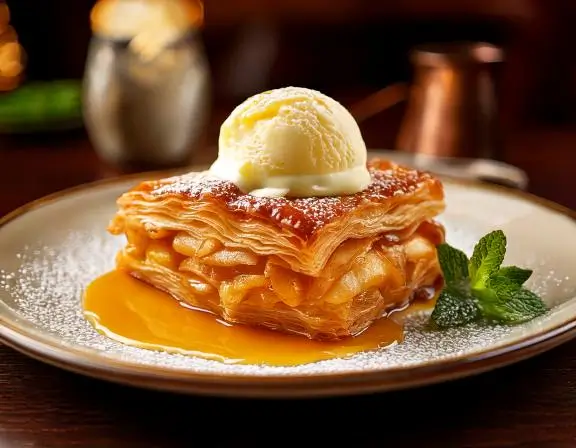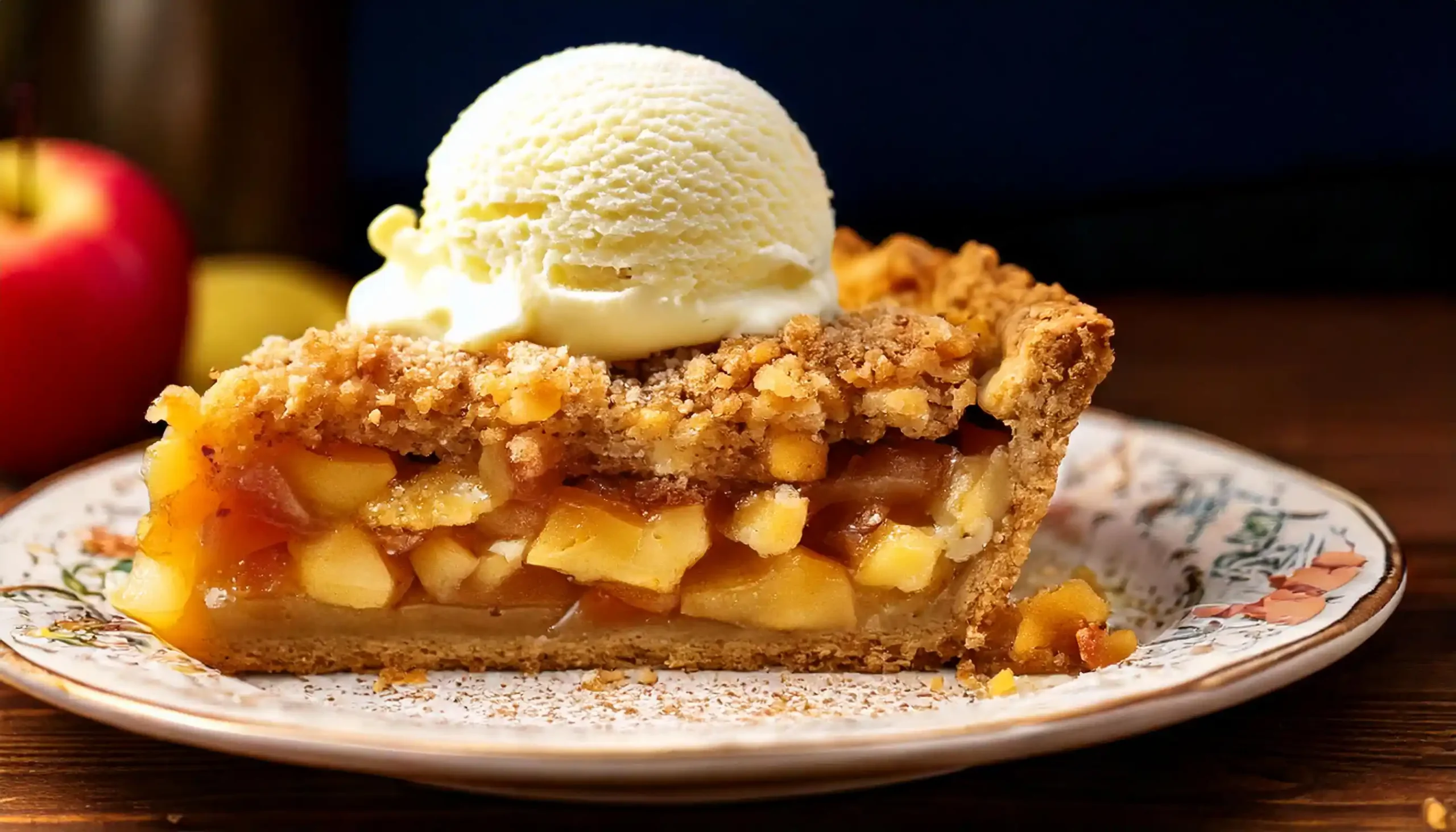Growing up, the kitchen was always the heart of our home — especially when autumn rolled in with its crisp air and apple-scented breeze.
Now, as a wife and mom of two lively little ones, I cherish recreating that same warmth and magic for my family. One of our absolute favorites? This French Apple Pie with Streusel Topping — a beautiful marriage between rustic French pastry and comforting American homestyle baking.
What makes this pie so special is its tender, buttery crust filled with sweet-tart apples and crowned with a golden, crumbly streusel topping. It’s a pie that feels elegant enough for guests, yet cozy enough for a casual Sunday dinner — and the best part? It’s perfect for any season! Whether it’s a holiday gathering or just a Wednesday treat, this pie always brings smiles around the table.
Ingredients
For the Pie Crust:
- 1 ¼ cups all-purpose flour
- 1 tablespoon granulated sugar
- ½ teaspoon salt
- 8 tablespoons (1 stick) cold unsalted butter, diced
- 3–4 tablespoons ice water
For the Apple Filling:
- 6 medium apples (Granny Smith and Honeycrisp work wonderfully), peeled, cored, and sliced
- ⅓ cup granulated sugar
- ¼ cup brown sugar, packed
- 2 tablespoons all-purpose flour
- 1 teaspoon cinnamon
- ¼ teaspoon nutmeg
- ¼ teaspoon allspice
- 1 tablespoon lemon juice
- 1 teaspoon pure vanilla extract
For the Streusel Topping:
- ¾ cup all-purpose flour
- ⅓ cup brown sugar
- ⅓ cup granulated sugar
- ½ teaspoon cinnamon
- Pinch of salt
- 6 tablespoons cold unsalted butter, cut into cubes
Instructions
1. Prepare the Pie Crust:
- In a large bowl, whisk together the flour, sugar, and salt.
- Add the cold, diced butter and use a pastry cutter (or your fingers!) to work the butter into the flour until the mixture resembles coarse crumbs.
- Gradually drizzle in ice water, one tablespoon at a time, mixing just until the dough comes together. Be careful not to overwork it!
- Shape the dough into a disk, wrap it tightly in plastic wrap, and chill in the fridge for at least 1 hour.
2. Make the Apple Filling:
- In a big mixing bowl, toss the sliced apples with the granulated sugar, brown sugar, flour, cinnamon, nutmeg, allspice, lemon juice, and vanilla extract until evenly coated.
- Let the mixture sit while you prepare the streusel — this helps the flavors to meld beautifully!
3. Prepare the Streusel Topping:
- In another bowl, combine the flour, brown sugar, granulated sugar, cinnamon, and salt.
- Add the cold butter cubes and work them in with your fingers or a pastry cutter until crumbly. (Little buttery clumps are exactly what you want!)
4. Assemble the Pie:
- Preheat your oven to 375°F (190°C).
- Roll out the chilled pie dough on a lightly floured surface and gently place it into a 9-inch pie dish. Trim and crimp the edges as you like — don’t stress about perfection; rustic pies have all the charm!
- Pour the apple filling into the crust, arranging it evenly.
- Sprinkle the streusel topping generously over the apples.
5. Bake:
- Bake the pie in the preheated oven for 50–60 minutes, until the topping is golden brown and the filling is bubbling.
- If the streusel browns too quickly, loosely tent the pie with aluminum foil during the last 15 minutes.
6. Cool and Serve:
- Allow the pie to cool for at least 2 hours before slicing — this lets the filling set up perfectly.
- Serve it plain, or with a big scoop of vanilla ice cream or a dollop of whipped cream!
Tips for the Perfect French Apple Pie
- Use a mix of apple varieties: Granny Smith for tartness and Honeycrisp for sweetness create the perfect flavor balance.
- Keep the butter cold: For both the crust and the streusel, cold butter gives you that flaky, tender texture we all love.
- Don’t skip resting the dough: It’s tempting to rush, but chilling the dough relaxes the gluten and prevents shrinkage.
- Taste your apples: Apples vary in sweetness! Adjust your sugar if needed.
- Bake it on a lower oven rack: This helps the bottom crust cook through without getting soggy.
Serving Ideas
There’s something magical about the first slice of this French Apple Pie — that crackly streusel topping, the buttery crust, the tender apples… it’s pure bliss. Here are a few of my favorite ways to serve it:
- Classic Style:
Serve the pie slightly warm with a generous scoop of vanilla bean ice cream. The creaminess melts into the pie, creating the dreamiest bite. - With Homemade Whipped Cream:
A simple whipped cream with a hint of cinnamon or vanilla adds a cloud of sweetness that pairs so beautifully with the spiced apples. - A Drizzle of Caramel Sauce:
For extra indulgence, drizzle warm caramel sauce over each slice just before serving. (Pro tip: kids love helping with the drizzling!) - Breakfast Treat:
Warm a slice gently and enjoy it with a cup of coffee for a cozy weekend breakfast — because sometimes, pie for breakfast is a must. - Mini Pie Slices for Parties:
Cut the pie into small wedges for a dessert table — it’s always one of the first treats to disappear at gatherings!
Storage Tips
Because life is busy (especially with little ones running around!), it’s good to know that this pie stores beautifully:
- Room Temperature:
If you plan to eat the pie within 1–2 days, you can keep it covered loosely at room temperature. - Refrigerator:
For longer storage, cover the pie tightly with plastic wrap or foil and refrigerate for up to 5 days. It reheats nicely in the oven at 300°F (150°C) for about 10–15 minutes. - Freezer:
Want to make it ahead? Bake the pie completely, let it cool, then wrap it tightly and freeze it for up to 3 months. Thaw overnight in the refrigerator and warm it up in the oven before serving — and it’s just as delicious as fresh!
Why You’ll Love This French Apple Pie
- Simple Ingredients, Big Flavor:
No fancy gadgets or tricky steps here — just wholesome ingredients coming together in the most delicious way. - Family-Friendly:
This pie is kid-approved in our house! My little ones love helping sprinkle the streusel, and seeing them beam with pride when they take that first bite is everything. - Perfect for Every Season:
Whether it’s summer with fresh apples from the orchard, cozy autumn gatherings, holiday feasts, or a simple spring treat, this pie fits right in. - Make-Ahead Magic:
Bake it ahead for holidays or busy weekends — it stores and freezes like a dream, making it a stress-free dessert. - That Crumbly, Buttery Streusel:
Let’s be honest — the buttery, slightly crisp topping steals the show! (Even my husband secretly picks off extra streusel pieces. )
French Apple Pie FAQ
Q: What are the best apples to use?
A: A mix of Granny Smith and Honeycrisp gives you the perfect sweet-tart balance. You can also try Pink Lady or Braeburn!
Q: Can I use store-bought pie crust?
A: Absolutely! While homemade crust is amazing, using a good-quality store-bought one makes this recipe even quicker.
Q: Can I make it gluten-free?
A: Yes! Substitute the all-purpose flour for a gluten-free 1:1 baking flour. Just make sure it includes xanthan gum for the best texture.
Q: How do I prevent a soggy bottom crust?
A: Bake your pie on the lower rack of the oven and make sure the filling isn’t too watery. Let the apples sit a few minutes with the sugar mixture to release extra juices before assembling.
Final Thoughts
From my heart (and kitchen) to yours, I hope this French Apple Pie with Streusel Topping brings as much joy to your home as it does to ours.
There’s something truly special about sharing a homemade pie with the ones you love — the laughter, the little hands sneaking streusel crumbs, the cozy moments together.
If you bake this recipe, I’d love to hear about it! Snap a picture, tag me, or just drop a comment — because in my world, food always tastes better when it’s shared.
Happy baking, beautiful soul!

Apple Streusel Pie
Ingredients
- 1 ¼ cups all-purpose flour for pie crust
- 1 tablespoon granulated sugar for pie crust
- ½ teaspoon salt for pie crust
- 8 tablespoons cold unsalted butter, diced for pie crust
- 3–4 tablespoons ice water for pie crust
- 6 medium apples, peeled, cored, and sliced Granny Smith and Honeycrisp recommended
- ⅓ cup granulated sugar for apple filling
- ¼ cup brown sugar, packed for apple filling
- 2 tablespoons all-purpose flour for apple filling
- 1 teaspoon cinnamon for apple filling
- ¼ teaspoon nutmeg for apple filling
- ¼ teaspoon allspice for apple filling
- 1 tablespoon lemon juice for apple filling
- 1 teaspoon pure vanilla extract for apple filling
- ¾ cup all-purpose flour for streusel topping
- ⅓ cup brown sugar for streusel topping
- ⅓ cup granulated sugar for streusel topping
- ½ teaspoon cinnamon for streusel topping
- 1 pinch salt for streusel topping
- 6 tablespoons cold unsalted butter, cut into cubes for streusel topping
Instructions
- In a large bowl, whisk together the flour, sugar, and salt for the pie crust.
- Add the cold, diced butter and use a pastry cutter or your fingers to work the butter into the flour until the mixture resembles coarse crumbs.
- Gradually drizzle in ice water, one tablespoon at a time, mixing just until the dough comes together.
- Shape the dough into a disk, wrap it tightly in plastic wrap, and chill in the fridge for at least 1 hour.
- In a large mixing bowl, toss the sliced apples with granulated sugar, brown sugar, flour, cinnamon, nutmeg, allspice, lemon juice, and vanilla extract until evenly coated.
- Let the apple mixture sit while you prepare the streusel topping.
- In another bowl, combine the flour, brown sugar, granulated sugar, cinnamon, and salt for the streusel.
- Add the cold butter cubes and work them in with your fingers or a pastry cutter until crumbly.
- Preheat your oven to 375°F (190°C).
- Roll out the chilled pie dough on a lightly floured surface and gently place it into a 9-inch pie dish. Trim and crimp the edges as desired.
- Pour the apple filling into the prepared crust, arranging it evenly.
- Sprinkle the streusel topping generously over the apples.
- Bake the pie for 50–60 minutes, until the topping is golden brown and the filling is bubbling. If the topping browns too quickly, tent with aluminum foil during the last 15 minutes.
- Allow the pie to cool for at least 2 hours before slicing to let the filling set.
- Serve plain, or with vanilla ice cream or whipped cream!

